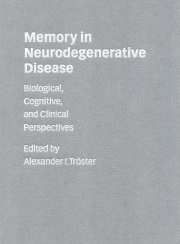Book contents
- Frontmatter
- Contents
- List of contributors
- Preface
- PART I Biological perspectives
- PART II Cognitive perspectives
- 8 The role of executive deficits in memory disorders in neurodegenerative disease
- 9 Prospective memory in aging and neurodegenerative disease
- 10 Remote memory in neurodegenerative disease
- 11 Semantic memory in neurodegenerative disease
- 12 Nondeclarative memory in neurodegenerative disease
- 13 Memory in neurodegenerative disease: what has been learned about the organization of memory?
- PART III Clinical perspectives
- Index
8 - The role of executive deficits in memory disorders in neurodegenerative disease
from PART II - Cognitive perspectives
Published online by Cambridge University Press: 23 November 2009
- Frontmatter
- Contents
- List of contributors
- Preface
- PART I Biological perspectives
- PART II Cognitive perspectives
- 8 The role of executive deficits in memory disorders in neurodegenerative disease
- 9 Prospective memory in aging and neurodegenerative disease
- 10 Remote memory in neurodegenerative disease
- 11 Semantic memory in neurodegenerative disease
- 12 Nondeclarative memory in neurodegenerative disease
- 13 Memory in neurodegenerative disease: what has been learned about the organization of memory?
- PART III Clinical perspectives
- Index
Summary
INTRODUCTION
There is now overwhelming evidence that patients with neurodegenerative disorders, including Parkinson's disease (PD), Huntington's disease (HD), progressive supranuclear palsy (also known as Steele-Richardson-Olszewski syndrome), multiple system atrophy, Alzheimer's disease (AD), Korsakoff's syndrome and fronto-striatal dementia exhibit diverse patterns of cognitive impairment that can include deficits of ‘executive function’. The term ‘executive function’ generally refers to those mechanisms by which performance is optimized in situations requiring the simultaneous operation of a number of different cognitive processes (Baddeley 1986). Executive functioning is required, therefore, when sequences of responses must be generated and scheduled and when novel plans of action must be formulated and carried out. The frontal lobes have long been known to play an important role in executive functioning, although the fact that the ‘dysexecutive syndrome’ may be observed in patients with damage to other brain regions (Morris et al. 1990), suggests that an equivalence between the prefrontal cortex and executive functioning cannot be assumed. In addition, much of the research on executive deficits in neurodegenerative groups has focused on broad descriptions of individual patient groups and how their behaviour might best be characterized using standard clinical neuropsychological tools. For example, impairments on the Wisconsin Card Sorting Test (Grant and Berg 1948), a classic test of executive function, have been described in many neurodegenerative groups including PD (Lees and Smith 1983), progressive supranuclear palsy (Pillon et al. 1986) and HD (Josiassen et al. 1983).
- Type
- Chapter
- Information
- Memory in Neurodegenerative DiseaseBiological, Cognitive, and Clinical Perspectives, pp. 157 - 171Publisher: Cambridge University PressPrint publication year: 1998
- 11
- Cited by

